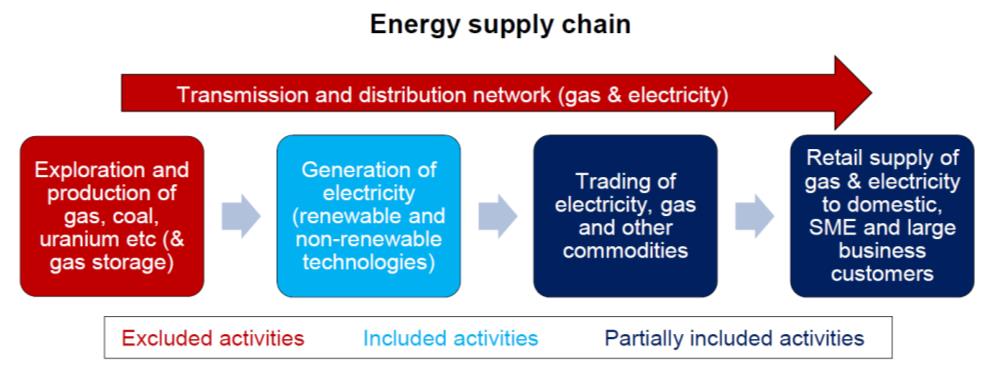 CMA Energy Market Investigation – Updated Issues Statement
CMA Energy Market Investigation – Updated Issues Statement
Catherine Mitchell, IGov Team, 18th February 2015
The Competition and Mergers Authority (CMA) has just published an Updated issues Statement. This is one of a series of consultative documents which will be published during the course of the investigation for before publication of the provisional findings in May 2015.
Source: CMA 2014: 6
The Updated Issues Statement sets out a number of areas where the CMA has come to preliminary, but not final, findings and also areas where they would like to have more information. As the CMA says, this updated issues statement – which sets out their ideas or gaps of knowledge in a reasonably brief fashion – should be read alongside a very useful and interesting set of working papers which explain those ideas or gaps. These are listed in Annex A of the document and below.
The CMA has also updated its Theories of Harm – moving from the original 4 to an updated set of 5, which now includes wider regulatory and market concerns – which we, the EPG, argued for in our submission and our oral evidence. The original and updated Theories of Harm are set out below.
The CMA Investigation is continuing to take evidence. Anyone who wishes to makes comments on this latest document should send their comments to energymarket@cma.gsi.gov.uk by 18 March 2015.
Theories of Harm
The original theories of harm the CMA identified in the issues statement were as follows:
- Theory of harm 1: opaque prices and/or low levels of liquidity in wholesale electricity markets create barriers to entry in retail and generation, perverse incentives for generators and/or other inefficiencies in market functioning.
- Theory of harm 2: vertically integrated electricity companies harm the competitive position of non-integrated firms to the detriment of the customer, either by increasing the costs of non-integrated energy suppliers or reducing the sales of non-integrated generating companies.
- Theory of harm 3: market power in electricity generation leads to higher prices.
- Theory of harm 4: energy suppliers face weak incentives to compete on price and non-price factors in retail markets, due in particular to inactive customers, supplier behaviour and/or regulatory interventions
These have been replaced by the updated theories of harm in the light of the evidence the CMA received to date. The CMA concluded that the original Theories of Harm no longer provide a comprehensive statement of the issues they intend to investigate. Therefore the CMA amended the theories of harm for this investigation as follows:
- Updated theory of harm 1: the market rules and regulatory framework distort competition and lead to inefficiencies in wholesale electricity markets.
- Updated theory of harm 2: market power in electricity generation leads to higher prices.
- Updated theory of harm 3a: opaque prices and low liquidity in wholesale electricity markets distort competition in retail and generation.
- Updated theory of harm 3b: vertically integrated electricity companies act to harm the competitive position of non-integrated firms to the detriment of the consumer, either by increasing the costs of non-integrated energy suppliers or reducing the sales of non-integrated generating companies.
- Updated theory of harm 4: energy suppliers face weak incentives to compete on price and non-price factors in retail markets, due in particular to inactive customers, supplier behaviour and/or regulatory interventions.
- Updated theory of harm 5: the broader regulatory framework, including the current system of code governance, acts as a barrier to pro-competitive innovation and change.
As the CMA says in Paragraphs 27 and 28 ‘The main changes concern updated theories of harm 1 and 5. In relation to updated theory of harm 1, the scope of our investigation into the rules and regulatory framework governing wholesale electricity is not limited to the effects of low levels of liquidity and opaque prices, as stated under our original formulation, so we have broadened it. In relation to the updated theory of harm 5, several parties have submitted to us that elements of the codes system risk affecting competition either through distorting incentives, increasing barriers to entry or stifling innovation’.
Annex A: List of working papers
- Descriptive statistics: generation and trading
- Liquidity
- Wholesale electricity market rules
- Market power in generation
- Foreclosure
- Wholesale gas market
- Locational pricing in the electricity market in Great Britain
- Capacity
- Descriptive statistics: retail
- Price comparison websites
- The pricing strategies of the Six Large Energy Firms in the retail supply of electricity and gas to domestic customers
- Customer survey: GfK Report
- Analysis of the potential gains from switching
- Cost pass-through
- Microbusinesses
- Gas and electricity settlement and metering
- Case studies on barriers to entry and expansion in the retail supply of energy
- Analysis of generation profitability
- Profitability of retail energy supply: profit margin analysis
- Legal and regulatory framework
- Coordination in the retail energy market facilitated by price announcements
- Analysis
Related Posts
« Previous New Thinking: Turning a First Step into a Journey: Energy Efficiency in the Private Rental Sector Presentation: The IGov Project Next »








